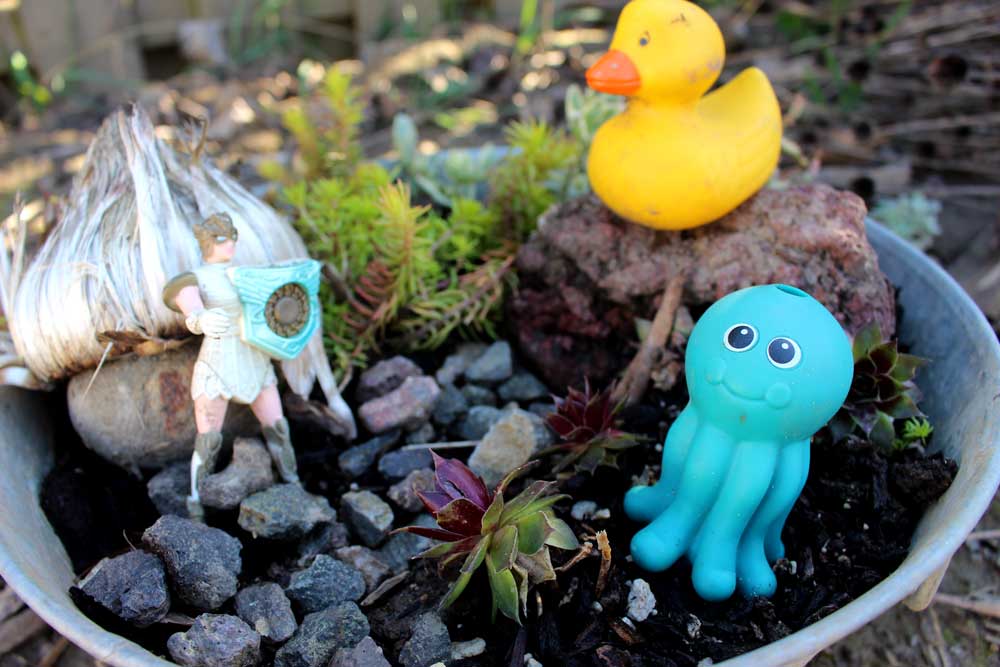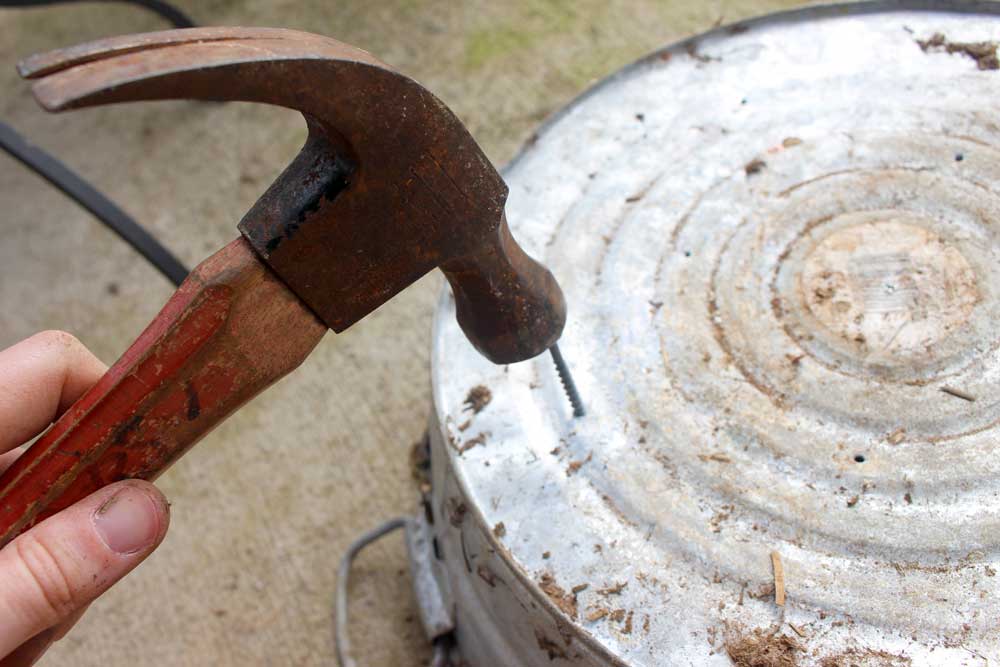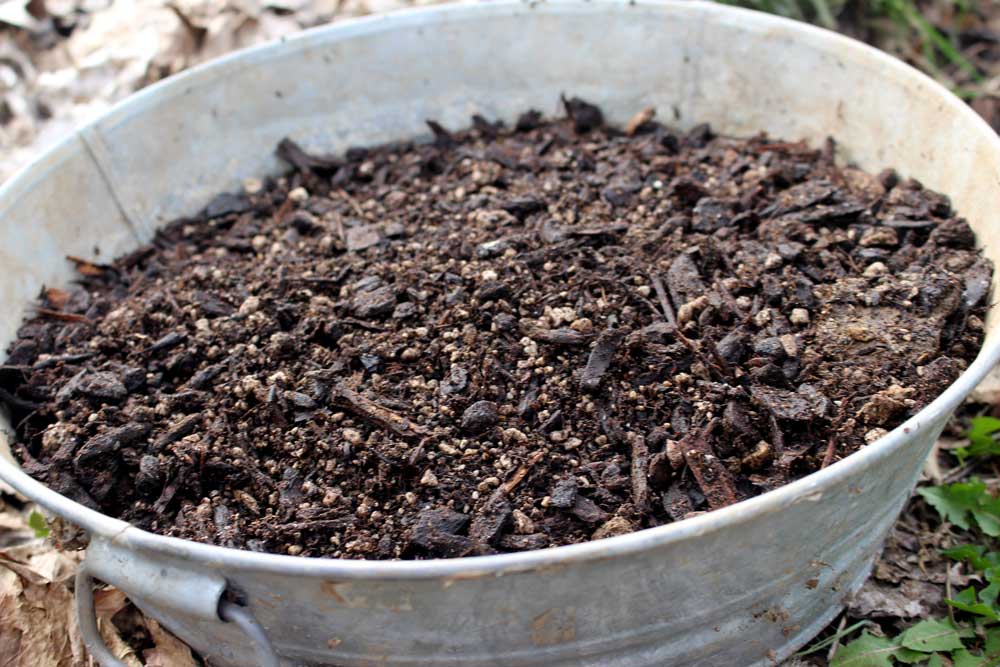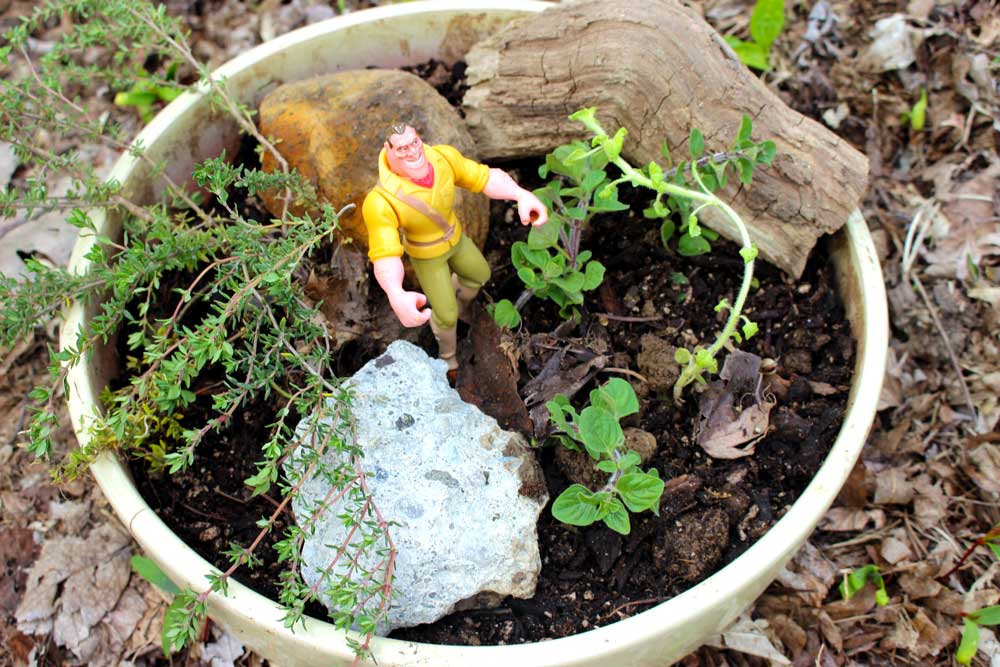This spring I began adding nature play “stations” throughout the homestead to make our outdoor space feel even bigger. I created a series of small fairy gardens at these stations using simple materials with Juniper’s help. They were easy projects to do together and have made a fun addition to the homestead.

Fairy gardens fit into the smallest spaces to extend play options in the garden
Our homestead has different use zones: intensive vegetable growing in the raised beds, an all-season outdoor gathering space, livestock and compost systems, meandering paths for strolling and a central open area for play. That nature play area includes a sand table (with cover to keep cats out), natural log seating and a teepee that is both kid hideout and pole bean support. The small fairy garden stations give the kids more options for quiet play in a somewhat secluded pocket, while also getting them moving all around the garden to burn off some energy.

Center of our homestead: the main nature play area surrounded by raised beds, fruit trees and in view from the patio
Making a fairy garden is as easy or complex as you want it to be! All you really need is a container, potting soil, plant starts and some imagination. You’re trying to set the stage for a miniature world, leaving room for kids to add play figurines, build tiny houses or whatever else they dream up. And less is better, as they will add to it and change the garden over time.

Hammer holes into tin containers for drainage
I went the easy and thrifty route with our fairy gardens by using second hand containers. I hammered drainage holes into a wide, shallow metal wash bin I discovered. Our shed has a forgotten ceramic planter I dusted off. And I used potting soil leftover from my seed starts.

Low, metal wash basin repurposed as a fairy garden container
Think about stacking functions as you pick your plants. I cut out some offshoots with roots attached from our herb garden of thyme and oregano. As they grow in, it’s another place I can dash out to harvest from when we’re making dinner.

Fairy garden planted with cuttings from the herb garden
Another container we filled with succulents and sedums. This fairy garden is located in the furthest corner of the garden, where we will inevitably forget to water. These plants require low water and will thrive when left alone this summer.

Fairy garden planted with low-water sedums and succulents. Decorated with rocks and a dried artichoke flower.
We are really pleased with these easy-peasey additions to the homestead. I would love to hear your ideas on how you integrate play into your homestead! How else do you get the whole family or household involved in your outdoor space? Tell me about it in the comments below!
The post How to Build a Fairy Garden Planter first appeared on Hip Chick Digs.

Fairy gardens fit into the smallest spaces to extend play options in the garden
Our homestead has different use zones: intensive vegetable growing in the raised beds, an all-season outdoor gathering space, livestock and compost systems, meandering paths for strolling and a central open area for play. That nature play area includes a sand table (with cover to keep cats out), natural log seating and a teepee that is both kid hideout and pole bean support. The small fairy garden stations give the kids more options for quiet play in a somewhat secluded pocket, while also getting them moving all around the garden to burn off some energy.

Center of our homestead: the main nature play area surrounded by raised beds, fruit trees and in view from the patio
Making a fairy garden is as easy or complex as you want it to be! All you really need is a container, potting soil, plant starts and some imagination. You’re trying to set the stage for a miniature world, leaving room for kids to add play figurines, build tiny houses or whatever else they dream up. And less is better, as they will add to it and change the garden over time.

Hammer holes into tin containers for drainage
I went the easy and thrifty route with our fairy gardens by using second hand containers. I hammered drainage holes into a wide, shallow metal wash bin I discovered. Our shed has a forgotten ceramic planter I dusted off. And I used potting soil leftover from my seed starts.

Low, metal wash basin repurposed as a fairy garden container
Think about stacking functions as you pick your plants. I cut out some offshoots with roots attached from our herb garden of thyme and oregano. As they grow in, it’s another place I can dash out to harvest from when we’re making dinner.

Fairy garden planted with cuttings from the herb garden
Another container we filled with succulents and sedums. This fairy garden is located in the furthest corner of the garden, where we will inevitably forget to water. These plants require low water and will thrive when left alone this summer.

Fairy garden planted with low-water sedums and succulents. Decorated with rocks and a dried artichoke flower.
We are really pleased with these easy-peasey additions to the homestead. I would love to hear your ideas on how you integrate play into your homestead! How else do you get the whole family or household involved in your outdoor space? Tell me about it in the comments below!
The post How to Build a Fairy Garden Planter first appeared on Hip Chick Digs.
